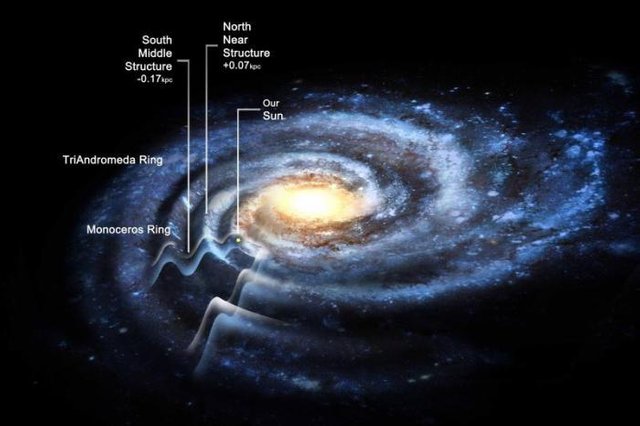Milky Way may be much larger than we suppose
Our Milky Way galaxy may be at least 50 percent more than it is now commonly assumed. This conclusion follows from the statement that the galactic disk is not flat, and distorted in the form of concentric bulges (ripple) as if you throw a stone into the water and watch the spread circles on its surface. This study was conducted by an international team of scientists led by Professor Rensselaer Polytechnic Institute Heidi Jo Newberg. In its work, the authors repeatedly appealed to the data the Sloan Digital Sky survey, which in 2002 established the presence of the convex ring of stars, lying outside the plane of the Milky Way known.
"Generally speaking, we found that the disk of the Milky Way is not flat, but wrinkled. As soon as we see farther and farther away from the Sun, we see at least four in-plane distortion. At that time, we can learn so only part of the galaxy, we assume that this behavior of matter can be found everywhere in the galaxy "- Heidi Nberg.
It is important that our results suggest that these features, previously identified as the rings are actually a part of the galactic disk, allowing you to change your view of the width of the Milky Way. Now it is about 100,000 light-years, and according to new calculations, this value may be equal to 150,000 light-years.
"Once started these studies, astronomers have noticed that the number of stars in the Milky Way is considerably reduced at the border of 50,000 light-years from the galactic center, and then there is the ring of stars at a distance of 60,000 light years from the center. And in fact, we believe we are witnessing is not a ring, but a ripple in the drive, which first goes up and then down, taking over a stars and all matter. And it may be that we continue to find even more of these effects. "
This study was even published in the Astrophysical Journal entitled "Rings and Radial are free in the disk of the Milky Way." In this paper, the scientists describe how they used data from the SDSS, to show fluctuating asymmetry of the main sequence stars on either side of the galactic plane as seen from the Sun's position in the outward direction from the center of the galaxy. In other words, the researchers describe the perturbations in the disk of our galaxy, where he first upwards, then down, then up and down again.
This study relies on data of 2002, when Newberg established the existence of the Ring of the Unicorn (Monoceros Ring), ultra-dense cluster of stars in the outer edges of the galaxy, which sticks out above the galactic disk. Around the same time, Newburgh noticed signs of the existence of another ring, the rings of the Unicorn and the Sun, but was not able to continue the study. Now, thanks to the processing of large amounts of data from the SDSS researchers were able to return to this mystery.
"I wanted to find out what is different superdense cluster. These stars are thought previously owned the disk of the Milky Way, but they do not correspond to the distribution of the density of stars, which is expected for them. So I thought that this could possibly be another ring or extremely sparse dwarf galaxy. "
When were re-examined the data, then immediately able to detect four anomalies: one north of the galactic plane in 2 kiloparsecs from the sun, the other south of the plane at a distance of 4 to 6 kpc from the Sun, and the third is to the north of the plane at a distance of 8-10 kpc, and signs the fourth anomalies were found to the south of the plane at a distance of 12-16 kpc from the sun. Unicorn Ring is connected with the third distortion. Scientists have shown that these fluctuations are consistent with the position of the spiral arms of the Milky Way. They say that these results are consistent with recent findings that say that when a dwarf galaxy or cluster of dark matter passing through the Milky Way, would have a similar effect.
"All of this is similar to what would happen if you throw a stone into still water. If a dwarf galaxy close to the Milky Way's disk, it is through its gravitational force would have raised the matter of the spiral arm, and then, whenever passed, then pulled the material down. It just may create a wave-like patterns, outward from the center of the Milky way. "

An example of how it can be distorted by the Milky Way. Anomalies noted distortions, which were adopted for the objects that are out of the plane of the galaxy.
According to the Rensselaer Polytechnic Institute.
Rewrite: http://news.rpi.edu/content/2015/03/09/rippling-milky-way-may-be-much-larger-previously-estimated